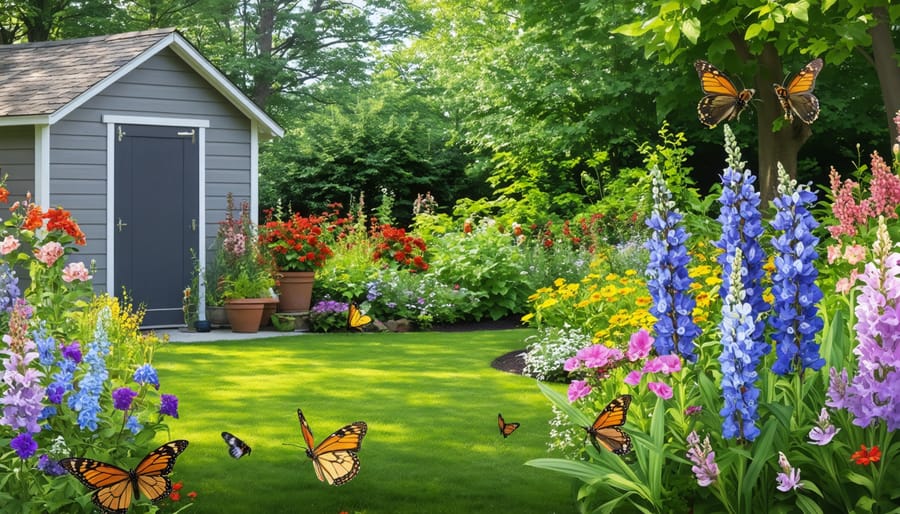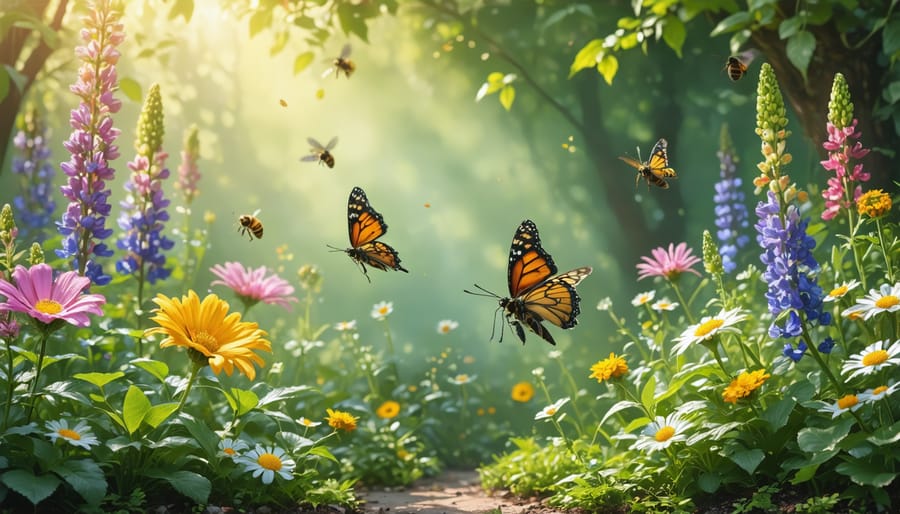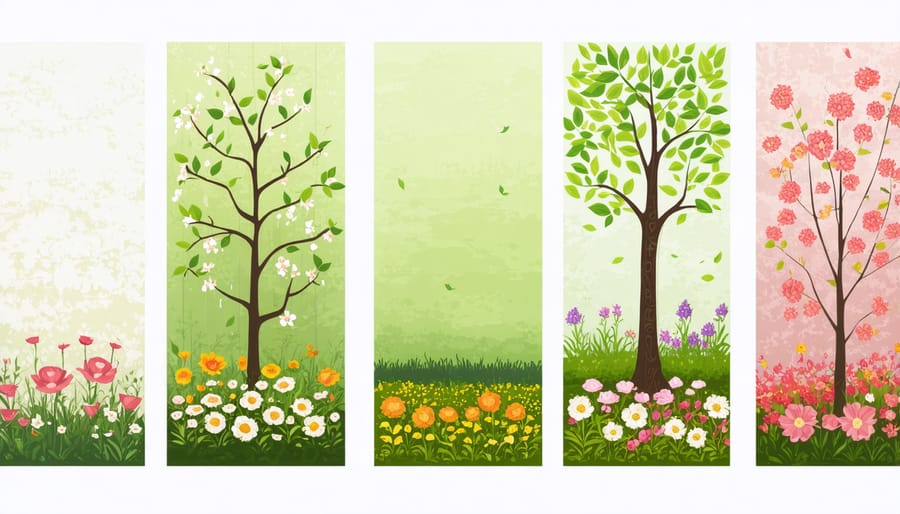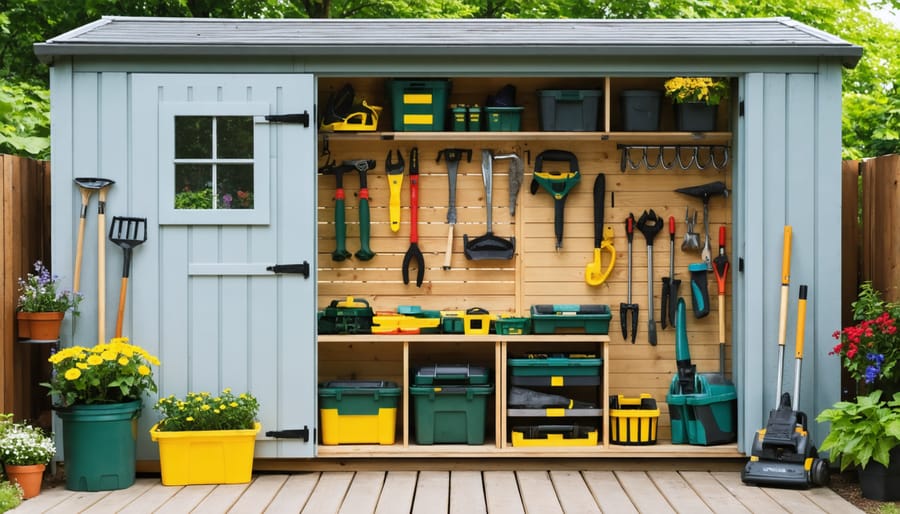Beautiful Yards That Buzz With Life: Your Easy Guide to Pollinator-Friendly Landscaping

Transform your outdoor space into a vibrant, sustainable sanctuary through eco-friendly landscaping that nurtures both wildlife and your connection to nature. Replace traditional grass lawns with native plant species that thrive naturally in your climate, reducing water consumption by up to 50% while creating essential habitats for local pollinators. Design multi-layered garden beds featuring ground covers, flowering perennials, and woody shrubs to establish resilient ecosystems that maintain themselves with minimal intervention. Incorporate rain gardens and bioswales to manage stormwater runoff naturally, preventing erosion while recharging groundwater supplies. These sustainable landscaping practices not only enhance your property’s visual appeal but also contribute to local biodiversity, reduce maintenance costs, and create a lasting positive impact on the environment. By choosing climate-appropriate plants and implementing water-wise design principles, you’ll establish a beautiful, low-maintenance landscape that serves as a model for environmental stewardship in your community.
Creating Your Pollinator Paradise: Essential Design Elements
Choosing the Perfect Location
Selecting the right location for your pollinator garden is crucial for both environmental impact and practical maintenance. Start by identifying sunny spots that receive at least 6 hours of direct sunlight daily, as most pollinator-friendly plants thrive in bright conditions. Consider areas near your storage shed or garden structure, which can provide a wonderful backdrop while maximizing otherwise unused space.
Look for locations that offer natural wind protection, such as areas adjacent to existing landscaping or structures. This shelter helps protect delicate plants and makes the space more inviting for butterflies and bees. Ensure your chosen spot has good drainage and easy access to water sources for convenient maintenance.
When planning near storage structures, leave at least 2-3 feet of clearance for maintenance access. This buffer zone also helps prevent moisture damage to your shed while creating a perfect transition between hardscape and garden areas. Consider visibility from your home’s windows too – watching pollinators at work can be a delightful bonus to your landscape design.
For maximum impact, place your garden where it can connect with existing natural areas or neighboring gardens, creating beneficial wildlife corridors that enhance your local ecosystem.
Layout and Flow Strategies
Creating an eco-friendly landscape starts with smart layout planning that maximizes both functionality and natural flow. Begin by mapping your garden into distinct zones based on purpose – relaxation areas, vegetable gardens, and storage spaces. This zoning approach helps create natural pathways while minimizing the impact on local wildlife habitats.
Consider positioning your storage solutions along the garden’s perimeter, where they can serve as windbreaks while blending seamlessly with surrounding vegetation. Natural screening, such as climbing plants or bamboo, can help integrate storage structures into the landscape while providing additional habitat for beneficial insects and birds.
When designing pathways, opt for permeable materials like gravel or stepping stones that allow water to seep into the ground naturally. Arrange these paths to create intuitive flow between different garden zones while minimizing soil compaction and protecting plant root systems.
Strategic placement of trees and larger shrubs can provide natural shade for both outdoor living spaces and storage areas, reducing cooling needs during summer months. Consider positioning deciduous trees on the southern side of storage structures to provide shade in summer while allowing warming sunlight during winter.
Create transition zones between storage areas and garden spaces using native plants and ground covers. These buffer zones not only soften the visual impact of storage structures but also provide additional wildlife corridors and help manage water runoff.
Remember to incorporate adequate spacing around storage areas for maintenance access while ensuring these spaces contribute to, rather than detract from, your garden’s overall ecological value. Using vertical gardening techniques near storage areas can maximize growing space while creating visually appealing green walls that benefit local pollinators.

Plant Selection for Year-Round Pollinator Support
Spring Bloomers
Spring bloomers are the cheerleaders of your eco-friendly landscape, welcoming the first pollinators of the season. Crocuses, snowdrops, and winter aconite break through late winter snow, providing essential nectar for early-emerging bees. These hardy plants not only add splashes of color to your garden but serve as crucial food sources when other options are scarce.
Consider planting native wildflowers like Virginia bluebells, spring beauty, and trillium, which have evolved alongside local pollinator populations. These plants are perfectly timed to support native bees and butterflies as they emerge from winter dormancy. Hellebores, another early bloomer, are particularly valuable as they flower for extended periods and thrive in shady areas.
Create clustered plantings rather than isolated specimens to make it easier for pollinators to spot and access the flowers. Remember to leave some open ground near your spring bloomers for ground-nesting bees, which are active in early spring. Adding early-flowering shrubs like witch hazel and pussy willow provides both nectar sources and potential nesting sites for beneficial insects.

Summer Sustenance
As summer heats up, maintaining a vibrant pollinator presence requires thoughtful plant selection. Consider adding Black-eyed Susans, which bloom prolifically from June through September, providing essential nectar for bees and butterflies. Purple coneflowers offer both visual appeal and sustenance, with their sturdy stems supporting multiple pollinators simultaneously.
Bee balm creates a spectacular mid-summer display while attracting hummingbirds and beneficial insects. For consistent blooming, incorporate both early and late varieties of butterfly weed, which monarch butterflies find irresistible. Lavender not only provides aromatic pleasure but serves as a reliable food source for bees throughout the warmer months.
Layer your garden with different heights and blooming periods. Include native blazing star for vertical interest and reliable pollinator attraction. Russian sage offers silvery foliage and long-lasting purple blooms that bees particularly favor. For ground coverage, creeping thyme creates a fragrant carpet while supporting smaller pollinators.
Remember to maintain consistent moisture levels and avoid chemical pesticides to keep your summer garden a safe haven for beneficial insects.
Fall Favorites
As autumn approaches, your garden can become a vital refueling station for pollinators preparing for winter. Late-blooming perennials like asters, goldenrod, and sedum provide essential nectar sources when other flowers have faded. New England asters, with their vibrant purple blooms, are particularly attractive to monarch butterflies during their fall migration, while native goldenrod supports countless beneficial insects.
Consider adding joe-pye weed and ironweed, which reach impressive heights and create dramatic backdrops while offering substantial food sources for bees and butterflies. Russian sage continues flowering well into fall, providing both beauty and sustenance. Don’t forget about autumn-blooming native plants like witch hazel and hardy mums, which help bridge the gap between summer abundance and winter dormancy.
Leave seed heads standing through winter, especially on coneflowers and black-eyed Susans. These not only provide food for birds but also create winter interest in your landscape. Remember to delay garden cleanup until spring to provide shelter for overwintering beneficial insects and their larvae.
Native Plant Power
Transform your landscape into a thriving ecosystem by incorporating native plant species that naturally belong in your region. These local champions are perfectly adapted to your climate, requiring less water, fertilizer, and maintenance than exotic alternatives. They’ve evolved alongside local wildlife, providing essential food and shelter for butterflies, bees, and birds that keep your garden buzzing with life.
Native plants develop deep root systems that prevent soil erosion and improve water absorption, making them excellent choices for managing stormwater runoff. They’re also surprisingly tough – once established, they can withstand local weather extremes better than non-native options, saving you time and money on replacements.
Consider creating themed garden zones with native wildflowers, grasses, and shrubs. Not only will this approach create visual interest, but it’ll also establish natural corridors for beneficial insects and birds. Best of all, these plants maintain their beauty through changing seasons, offering year-round appeal while supporting local biodiversity. Remember, every native plant you add is a step toward a more sustainable and resilient landscape.
Maintenance Made Simple
Seasonal Care Calendar
Creating an effective year-round garden maintenance schedule is essential for an eco-friendly landscape. Here’s your month-by-month guide:
Spring (March-May):
• March: Start composting, clean up winter debris, and test soil
• April: Plant native perennials and early-season vegetables
• May: Mulch garden beds with organic materials, install rain barrels
Summer (June-August):
• June: Establish natural pest control methods, deep water established plants
• July: Harvest vegetables, maintain pollinator gardens, collect seeds
• August: Practice selective pruning, monitor water usage
Fall (September-November):
• September: Plant fall bulbs, collect leaves for composting
• October: Reduce watering, protect sensitive plants
• November: Apply winter mulch, clean and store garden tools
Winter (December-February):
• December: Maintain winter wildlife habitats
• January: Plan next season’s garden, order native seeds
• February: Start indoor seedlings, maintain compost
Monthly Constants:
• Check irrigation systems for leaks
• Monitor pest activity using natural solutions
• Maintain compost pile
• Remove invasive species
• Observe and document wildlife activity
Remember to adjust these tasks based on your local climate and growing zone. Use sustainable practices like hand-pulling weeds instead of herbicides and choosing drought-resistant plants to reduce water consumption. Store tools and supplies properly in your garden shed to extend their life and reduce waste.
Eco-Friendly Pest Management
Managing garden pests doesn’t have to mean reaching for harmful chemicals. Natural pest control methods protect both your garden and the beneficial insects that help it thrive. Start by encouraging natural predators like ladybugs, praying mantises, and birds by creating diverse habitats with native plants and water features.
Companion planting is a time-tested strategy that works wonders. Plant aromatic herbs like basil, mint, and marigolds throughout your garden – they naturally repel many common pests while adding beauty to your landscape. Lavender, for instance, not only deters moths and flies but also attracts pollinators.
For specific pest issues, try these eco-friendly solutions:
– Mix garlic and neem oil spray for aphid control
– Sprinkle diatomaceous earth around plants to deter crawling insects
– Place copper tape barriers to keep slugs and snails away
– Use coffee grounds to repel ants and cats
– Install bird feeders to attract natural pest controllers
Prevention is key in natural pest management. Maintain healthy soil through composting and regular mulching, as robust plants naturally resist pest problems. Rotate your crops annually to prevent pest populations from establishing themselves, and remove any diseased plants promptly to avoid spread.
Remember that some insect presence is normal and even beneficial for a healthy garden ecosystem. Focus on maintaining a balance rather than eliminating all insects. By implementing these natural solutions, you’ll create a thriving garden that works in harmony with nature while keeping pest problems at bay.
Storage Solutions for Your Garden Tools
Creating a harmonious balance between storage functionality and pollinator-friendly landscaping starts with smart planning. When you organize your garden tools, consider incorporating natural elements that benefit local wildlife while keeping your equipment protected and accessible.
Position your storage shed or cabinet where it won’t disrupt existing pollinator pathways. Consider installing a green roof on your storage structure, planted with native sedum or wildflowers that attract bees and butterflies. This dual-purpose approach not only provides essential habitat but also helps regulate the temperature inside your storage space.
Vertical storage solutions along shed walls free up ground space for butterfly-friendly plants near the entrance. Install hooks and pegboards at varying heights, keeping frequently used tools at eye level. For additional eco-benefits, collect rainwater from your shed’s roof using a barrel system, providing a water source for both your garden and visiting pollinators.
Create a natural screen around your storage area using climbing vines on trellises or native shrubs. This not only camouflages the structure but also provides additional nectar sources and shelter for beneficial insects. Choose plants like clematis or trumpet honeysuckle that flower throughout the season.
Remember to use sustainable materials for your storage solutions – reclaimed wood, recycled metal, or weather-resistant bamboo all make excellent choices that align with environmentally conscious landscaping principles.

Creating an environmentally friendly landscape is more than just a trend – it’s a meaningful way to support local ecosystems while enjoying a beautiful outdoor space. By incorporating native plants, providing water sources, and creating diverse habitats, you’re not only designing a stunning garden but also making a positive impact on your local environment. Remember, every pollinator-friendly feature you add, from flowering perennials to natural shelter spaces, contributes to the bigger picture of environmental conservation. Start small with a single flower bed or herb garden, and gradually expand your eco-friendly landscape as you become more comfortable with these sustainable practices. Your efforts will reward you with a vibrant, living landscape that buzzes with activity and brings joy throughout the seasons. Take that first step today – your local pollinators are counting on you!

